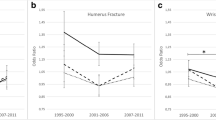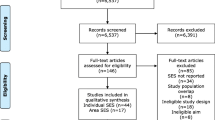Abstract
Summary
We investigated sex- and age-specific associations between income and fractures at the hip, humerus, spine, and forearm in adults aged ≥50 years. Compared to men with the highest income, men with the lowest income had an increased fracture risk at all skeletal sites. These associations were attenuated in women.
Introduction
Associations between income and hip fractures are contested, even less is known about other fracture sites. We investigated sex- and age-specific associations between income and major osteoporotic fractures (MOF) at the hip, humerus, spine, and forearm.
Methods
Incident fractures were identified from administrative health data for adults aged ≥50 years in Manitoba, Canada, 2000–2007. Mean neighborhood (postal code area) annual household incomes were extracted from 2006 census files and categorized into quintiles. We calculated age-adjusted and age-specific sex-stratified fracture incidence across income quintiles. We estimated relative risks (RR) and 95 % CI for income quintile 1 (Q1, lowest income) vs. income quintile 5 (Q5) and tested the linear trend across quintiles.
Results
We identified 15,094 incident fractures (4736 hip, 3012 humerus, 1979 spine, and 5367 forearm) in 2718 men and 6786 women. For males, the RR of fracture for the lowest vs. highest income quintile was 1.63 (95 % CI 1.42–1.87) and the negative trend was statistically significant (p < 0.0001); individual skeletal sites showed similar associations. For females, the RR of fracture for the lowest vs. highest income quintile was 1.14 (95 % CI 1.01–1.28), with a statistically significant negative trend (p = 0.0291); however, the only skeletal site associated with income in women was the forearm (Q1 vs. Q5 RR 1.09, 95 % CI 1.01–1.28).
Conclusions
Compared to men with the highest income, men with the lowest income had an increased fracture risk at all skeletal sites. These associations were attenuated in women. For men, these effect sizes seem large enough to warrant public health concern.

Similar content being viewed by others
References
Johnell O, Kanis JA (2006) An estimate of the worldwide prevalence and disability associated with osteoporotic fractures. Osteoporos Int 17:1726
Kanis JA, Oden A, McCloskey EV, Johansson H, Wahl DA, Cooper C, on behalf of the IOF Working Group on Epidemiology and Quality of Life (2012) A systematic review of hip fracture incidence and probability of fracture worldwide. Osteoporos Int 23:2239–2256
Brennan SL, Pasco JA, Urquhart DM, Oldenburg B, Hanna FS, Wluka AE (2009) The association between socioeconomic status and osteoporotic fracture in population-based adults: a systematic review. Osteoporos Int 49:165–171
Brennan SL, Henry MJ, Nicholson GC, Kotowicz MA, Pasco JA (2009) Socioeconomic status and risk factors for obesity and metabolic disorders in a population-based sample of adult females. Prev Med 49:165–171
Siegel D, Faigeles B (1996) Smoking and socioeconomic status in a population-based inner city sample of African-Americans, Latinos and whites. J Cardiovasc Risk 3:295–300
Milligan R, Burke V, Beilin U, Dunbar DL (1998) Influence of gender and socioeconomic status on dietary patterns and nutrient intakes in 18-year old Australians. Aust NZ J Public Health 22:485–493
Crespo CJ, Ainsworth BE, Keteyian SH, Heath GW et al (1999) Prevalence of physical inactivity and its relation to social class in US adults: results from the Third National Health and Nutrition Examination Survey, 1988–1994. Med Sci Sports Exerc 31:1821–1827
Brennan SL, Leslie WD, Lix LM (2013) Associations between adverse social position and bone mineral density in women aged 50 years or older: data from the Manitoba Bone Density Program. Osteoporos Int 24:2405–2412
Nutbeam D (2000) Health literacy as a public health goal: a challenge for contemporary health education and communication strategies into the 21st century. Health Promotion Int 15:259–267
Wilson RT, Chase GA, Chrischilles EA, Wallace RB (2006) Hip fracture risk among community-dwelling elderly people in the United States: a prospective study of physical, cognitive and socioeconomic indicators. Amer J Public Health 96:1210–1218
Farahmand BY, Persson PG, Michaelsson K, Baron JA, Parker MG, Ljunghall S (2000) Socioeconomic status, marital status and hip fracture risk: a population-based case-control study. Osteoporos Int 11:803–808
Icks A, Haastert B, Wildner M, Becker C, Rapp K, Dragano N, Meyer G, Rosenbauer J (2009) Hip fractures and area level socioeconomic conditions: a population-based study. BMC Public Health 9:1471
Vestergaard P, Rejnmark L, Mosekilde L (2006) Socioeconomic aspects of fractures within universal public healthcare: a nationwide case-control study from Denmark. Scand J Public Health 34:371–377
Brennan SL, Henry MJ, Kotowicz MA, Nicholson GC, Zhang Y, Pasco JA (2011) Incident hip fracture and social disadvantage in an Australian population aged 50 years or greater. Bone 48:607–610
Court-Brown CM, Aitken SA, Duckworth AD, Clement ND, McQueen MM (2013) The relationship between social deprivation and the incidence of adult fractures. J Bone Joint Surg Am 95:1–7
Crandall CJ, Han W, Greendale GA, Seeman T, Tepper P, Thurston R, Karvonen-Gutierrez C, Karlamangla AS (2014) Socioeconomic status in relation to incident fracture risk in the Study of Women’s Health Across the Nation. Osteoporos Int 25:1379–1388
Taylor AJ, Gary LC, Arora T, Becker DJ, Curtis JR, Kilgore ML, Morrisey MA, Saag KG, Matthews R, Yun H, Smith W, Delzell E (2011) Clinical and demographic factors associated with fractures among older Americans. Osteoporos Int 22:1263–1274
Peel NM, McClure RJ, Hendrikz JK (2007) Psychosocial factors associated with fall-related hip fractures. Age Ageing 36:145–151
Johnell O, Borgstrom F, Jonsson B, Kanis J (2007) Latitude, socioeconomic prosperity, mobile phones and hip fracture risk. Osteoporos Int 18:333–337
Roos NP (1999) Establishing a population data-based policy unit. Med Care 37:JS15–JS26
Leslie WD, O’Donnell S, Lagace C et al (2009) Population-based Canadian hip fracture rates with international comparisons. Osteoporos Int 21:1317–1322
(2005) U.S. Department of Health and Human Services, Centers for Disease Control and Prevention, and the Centers for Medicare and Medicaid Services; U.S. Department of Health and Human Services; Centers for Disease Control and Prevention; Centers for Medicare and Medicaid Services. International Classification of Diseases, Ninth Revision, Clinical Modification (ICD-9-CM), Sixth Edition. Odum Institute V2
Chateau D, Metge C, Prior H, Soodeen R-A (2012) Learning from the census: the socio-economic factor index (SEFI) and health outcomes in Manitoba. Can J Public Health 103:S23–S27
Bacon WE, Hadden WC (2000) Occurrence of hip fractures and socioeconomic position. J Aging Health 12:193–203
Zingmond DS, Soohoo NF, Silverman SL (2006) The role of socioeconomic status on hip fracture. Osteoporos Int 17:1562–1568
Jones S, Johansen A, Brennan J, Butler J, Lyons RA (2004) The effect of socioeconomic deprivation on fracture incidence in the United Kingdom. Osteoporos Int 15:520–524
Carstairs V, Morris R (1989) Deprivation and mortality: an alternative to social class? Comm Med 11:210–219
Court-Brown CM, Brydone A (2007) Social deprivation and adult tibial diaphyseal fractures. Injury 38:750–754
Horton TC, Dias JJ, Burke FD (2007) Social deprivation and hand injury. J Hand Surg Eur 32:256–261
Seifert-Klauss V, Link T, Heumann C, Luppa P, Haseitl M, Laakmann J, Rattenhuber J, Kiechle M (2006) Influence of pattern of menopausal transition on the amount of trabecular bone loss. Results from a 6-year prospective longitudinal study. Maturitas 55:317–324
Leslie WD, Brennan SL, Prior HJ, Lix LM, Metge C, Elias B (2012) The post-fracture care gap among Canadian First Nations peoples: a retrospective cohort study. Osteoporos Int 23:929–936
Kanis JA, Oden A, Johansson H, Borgstrom F, Strom O, McCloskey E (2009) FRAX and its applications to clinical practice. Bone 44:734–743
Mustard CA, Derksen S, Berthelot JM, Wolfson M (1999) Assessing ecologic proxies for household income: a comparison of household and neighbourhood level income measures in the study of population health status. Health Place 5:157–171
(2010) http://mchp-appserv.cpe.umanitoba.ca/viewDefinition.php?definitionID=102883. In Manitoba Centre for Health Policy (ed). Manitoba Centre for Health Policy, Winnipeg
Acknowledgments
The authors acknowledge the Manitoba Centre for Health Policy (MCHP) for use of data contained in the Population Health Research Data Repository (HIPC project number 2008/2009-16). The results and conclusions are those of the authors, and no official endorsement by the MCHP, Manitoba Health, or other data providers is intended or should be inferred. This project was funded through a research grant from Amgen Canada Ltd. The funding source had no access to the data prior to publication, no input into the writing of the manuscript, and no input in the decision to publish the results. SL Brennan was supported by a National Health and Medical Research Council (NHMRC) of Australia Early Career Fellowship (GNT1012472). SN Morin is chercheur-boursier des Fonds de Recherche du Québec en Santé. LM Lix is supported by a Manitoba Health Research Chair. SR Majumdar holds the Endowed Chair in Patient Health Management (Faculties of Medicine and Dentistry and Pharmacy and Pharmaceutical Sciences, University of Alberta) and receives salary support as a Health Scholar of the Alberta Heritage Foundation for Medical Research and Alberta Innovates-Health Solutions.
Conflicts of interest
Suzanne N. Morin is a consultant to Amgen, Eli Lilly, and Merck and a speaker bureau to Amgen and Eli Lilly. She received a research grant from Amgen and Merck. William D. Leslie is a speaker bureau to Amgen, Eli Lilly, and Novartis. He received research grants from Amgen and Genzyme. Sharon L. Brennan, Lin Yan, Lisa M. Lix, and Sumit Majumdar have no conflicts to declare.
Author information
Authors and Affiliations
Corresponding author
Rights and permissions
About this article
Cite this article
Brennan, S.L., Yan, L., Lix, L.M. et al. Sex- and age-specific associations between income and incident major osteoporotic fractures in Canadian men and women: a population-based analysis. Osteoporos Int 26, 59–65 (2015). https://doi.org/10.1007/s00198-014-2914-z
Received:
Accepted:
Published:
Issue Date:
DOI: https://doi.org/10.1007/s00198-014-2914-z




